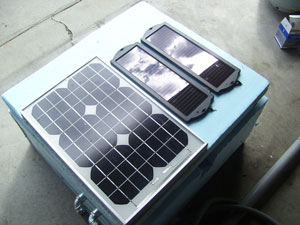Here fishy, fishy
You wouldn’t think that a two-year college, with students coming and going as frequently as a bus at a bus stop would be able to accomplish much. But when you combine four school departments under the direction of Lon Youngberg, George F. Uhlig and Ross Sacco, you can get amazing results.
It only took two-and-a-half years to complete the service learning BASS project: “Two years for the 40-plus students involved to build and six months for the “old man” to fix it,” commented Uhlig.

This archived article was written by: Maria Bjarson
You wouldn’t think that a two-year college, with students coming and going as frequently as a bus at a bus stop would be able to accomplish much. But when you combine four school departments under the direction of Lon Youngberg, George F. Uhlig and Ross Sacco, you can get amazing results.
It only took two-and-a-half years to complete the service learning BASS project: “Two years for the 40-plus students involved to build and six months for the “old man” to fix it,” commented Uhlig.
Moldano, resident of the Utah Bass Federation, came to Uhlig asking for help to resolve a crisis at Lake Powell: the bass fish, which are cannibalistic, were eating their young, and with the dropping waters the young were running out of aquatic environments tohide in. Moldano asked Uhlig to create a retuge for the young bass to grow and develop in.
Sounds simple enough right? Wrong! The project is far more intriguing than just a refuge for young bass.
From the outside you see a sky-blue box with solar-panels attached to the top. There are two tubes extruding from the side of it. One tube has lights attached to one end, which will float above the water. It flashes blue to warn boats about the device floating underneath, and it flashes red to indicate that something is malfunctioning inside the box.
Underneath the device floats the refuge for the bass. It needs to constantly be at a certain depth and therefore needs an anchor of around 6,000 pounds to hold it in place, and a program to regulate the rise and change of water. This information is contained inside of the water-proof container.
When looking into the box, it’s just a maze of wires that connect to a self-rechargeable battery (thus the solar-panels) and a computer chip with all of the information held on it. It is quite amazing really.
The first prototype was completed in the spring of 2006 and taken to the Green River to be tested by students. Students, not knowing better, dropped the project into the water. The impact of the water short-circuited the prototype and it was brought back to CEU to be repaired.
Uhlig ended up spending the next six months calking and water-proofing the machine.
Finally, on September 21, he took the finished product to the Utah Bass Federation. He stated that “only strong marriages survive engineering projects like the BASS project.”
It was a project that required much of his time. The finished prototype is a real time-saver and takes the place of six to seven people who would have had to manually raise and lower it otherwise. There will be many fish surrounding the BASS project: those who are taking refuge and those who are attempting to feed off of them. So next time you’re fishing at Lake Powell look for the flashing blue lights, because chances are that you will find scores of fish nearby.




